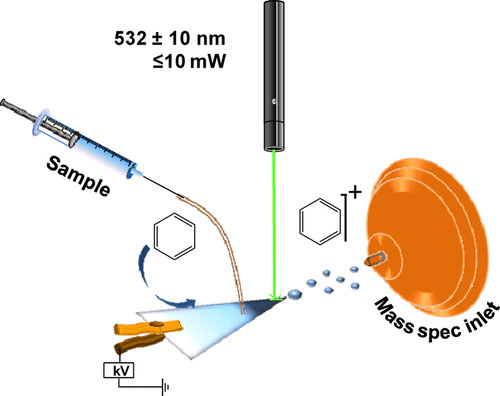当前位置:
X-MOL 学术
›
Anal. Chem.
›
论文详情
Our official English website, www.x-mol.net, welcomes your feedback! (Note: you will need to create a separate account there.)
Detection of Hydrocarbons by Laser Assisted Paper Spray Ionization Mass Spectrometry (LAPSI MS)
Analytical Chemistry ( IF 7.4 ) Pub Date : 2018-03-09 00:00:00 , DOI: 10.1021/acs.analchem.7b05213 Pallab Basuri 1 , Depanjan Sarkar 1 , Ganesan Paramasivam 1 , Thalappil Pradeep 1
Analytical Chemistry ( IF 7.4 ) Pub Date : 2018-03-09 00:00:00 , DOI: 10.1021/acs.analchem.7b05213 Pallab Basuri 1 , Depanjan Sarkar 1 , Ganesan Paramasivam 1 , Thalappil Pradeep 1
Affiliation

|
Here we introduce a new ambient ionization technique named laser assisted paper spray ionization mass spectrometry (LAPSI MS). In it, a 532 ± 10 nm, ≤10 mW laser pointer was shone on a triangularly cut paper along with high voltage, to effect ionization. The analyte solution was continuously pushed through a fused silica capillary, using a syringe pump, at a preferred infusion rate. LAPSI MS promises enhanced ionization with high signal intensity of polycyclic aromatic hydrocarbons (PAHs), which are normally not ionizable with similar ionization methods involving solvent sprays. LAPSI MS works both in positive and negative modes of ionization. A clear enhancement of signal intensity was visualized in the total ion chronogram for most analytes in the presence of the laser. We speculate that the mechanism of ionization is field assisted photoionization. The field-induced distortion of the potential well can be large in paper spray as the fibers comprising the paper are separated at tens of nanometers apart, and consequently, the analyte molecules are subjected to very large electric fields of the order of 107 Vcm–1. Ionization occurs from their distorted electronic states of reduced ionization energy, using the laser. Negative ion detection is also demonstrated, occurring due to the capture of produced photoelectrons. LAPSI MS can be used for monitoring in situ photoassisted reactions like the decarboxylation of mercaptobenzoic acid in the presence of gold and silver nanoparticles and the dehydrogenation reaction of 2,3-dihydro-1H-isoindole, which were chosen as examples. As an application, we have shown that paraffin oil, which is usually nonionizable by paper spray or by electrospray ionization can be efficiently detected using this technique. Impurities like mineral oils were detected easily in commercially available coconut oil, pointing the way to applications of social relevance.
中文翻译:

激光辅助纸喷雾电离质谱法(LAPSI MS)检测碳氢化合物
在这里,我们介绍了一种新的环境电离技术,称为激光辅助纸喷雾电离质谱(LAPSI MS)。其中,将532±10 nm,≤10mW的激光笔与高压一起照在三角形切纸上,以实现电离。使用注射泵以优选的注入速率将分析物溶液连续推动通过熔融石英毛细管。LAPSI MS有望以高信号强度增强多环芳烃(PAH)的电离,而多环芳烃通常无法通过涉及溶剂喷雾的类似电离方法进行电离。LAPSI MS可以在正电离模式和负电离模式下工作。在存在激光的情况下,大多数分析物的总离子时序图中显示了明显的信号强度增强。我们推测电离的机制是场辅助光电离。在纸浆喷涂中,势阱的场致畸变可能会很大,因为构成纸的纤维相隔数十纳米,因此,分析物分子要经受10量级的非常大的电场7 Vcm –1。使用激光,由于其畸变的电子状态降低了电离能量,从而发生了电离。还证实了负离子检测,这是由于捕获了产生的光电子而发生的。LAPSI MS可用于监测原位光辅助反应,例如在金和银纳米粒子存在下巯基苯甲酸的脱羧和2,3-二氢-1 H的脱氢反应-异吲哚,被选为实例。作为一种应用,我们已经表明,使用该技术可以有效地检测出石蜡油,该石蜡油通常可通过纸张喷雾或电喷雾电离而不可电离。诸如矿物油之类的杂质很容易在市售椰子油中检测到,这为应用具有社会意义的方法指明了方向。
更新日期:2018-03-09
中文翻译:

激光辅助纸喷雾电离质谱法(LAPSI MS)检测碳氢化合物
在这里,我们介绍了一种新的环境电离技术,称为激光辅助纸喷雾电离质谱(LAPSI MS)。其中,将532±10 nm,≤10mW的激光笔与高压一起照在三角形切纸上,以实现电离。使用注射泵以优选的注入速率将分析物溶液连续推动通过熔融石英毛细管。LAPSI MS有望以高信号强度增强多环芳烃(PAH)的电离,而多环芳烃通常无法通过涉及溶剂喷雾的类似电离方法进行电离。LAPSI MS可以在正电离模式和负电离模式下工作。在存在激光的情况下,大多数分析物的总离子时序图中显示了明显的信号强度增强。我们推测电离的机制是场辅助光电离。在纸浆喷涂中,势阱的场致畸变可能会很大,因为构成纸的纤维相隔数十纳米,因此,分析物分子要经受10量级的非常大的电场7 Vcm –1。使用激光,由于其畸变的电子状态降低了电离能量,从而发生了电离。还证实了负离子检测,这是由于捕获了产生的光电子而发生的。LAPSI MS可用于监测原位光辅助反应,例如在金和银纳米粒子存在下巯基苯甲酸的脱羧和2,3-二氢-1 H的脱氢反应-异吲哚,被选为实例。作为一种应用,我们已经表明,使用该技术可以有效地检测出石蜡油,该石蜡油通常可通过纸张喷雾或电喷雾电离而不可电离。诸如矿物油之类的杂质很容易在市售椰子油中检测到,这为应用具有社会意义的方法指明了方向。


























 京公网安备 11010802027423号
京公网安备 11010802027423号